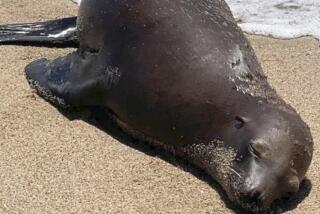Tern-Destroying Foxes Win Reprieve From Guns, Poison
An animal rights group Friday won a temporary restraining order barring the state Department of Fish and Game from shooting or poisoning red foxes preying on an endangered shore bird in the Bolsa Chica Ecological Reserve.
But Superior Court Commissioner Eleanor M. Palk ruled that the state may continue using steel-jaw traps to capture the non-native foxes, which biologists and state officials say are preying on the endangered least terns.
Palk set a July 19 hearing on the Animal Lovers Volunteer Assn.’s request for a permanent halt to the state’s red fox eradication program. In its lawsuit filed Friday in Superior Court in Santa Ana, the organization claimed that inhumane methods were being used to keep the foxes out of the wildlife reserve.
The group had sought the temporary restraining order because it claimed that Fish and Game officials had planned to conduct a nighttime shooting raid this weekend to kill foxes and possibly other nocturnal animals at the reserve, which borders Pacific Coast Highway and Huntington Beach.
“We were told they were going to have a government shooter out there with a sniper scope and a 12-gauge shotgun blowing up foxes and other animals,” said Hal Baerg of Huntington Beach, president of Animal Lovers Volunteer Assn., a group of about 3,400 people who live near Bolsa Chica.
“Any exploring pets from neighborhood homes may find themselves victims . . . as well as travelers along PCH, the oil field workers who are there seven nights a week, not to mention pedestrians and joggers,” Baerg said.
Earlier this month, state wildlife officials announced that they were considering the use of firearms and poison to protect the least tern, which is facing a drastic population decline during this breeding season.
The small shore bird has been on state and federal endangered-species lists for almost two decades. State officials said trapping efforts already were under way at the reserve to protect the small birds, whose nests--mere depressions in the sand--were being plundered by predators.
Both state and federal officials say that when a species is placed on the endangered list, they are mandated to take protective measures, even if they are aimed at other animals not on the endangered species list.
When a similar effort to trap red foxes was begun two years ago at the nearby Seal Beach National Wildlife Refuge, situated within the grounds of the Seal Beach Naval Weapons Station, the Animal Lovers Volunteer Assn. filed a lawsuit in federal court. The Navy and U.S. Fish and Wildlife officials had decided on trapping to eliminate the foxes, which they said were plundering the nests of endangered least terns and the light-footed clapper rail.
In September, U.S. District Judge Robert J. Kelleher denied the group’s request for an injunction. But the U.S. 9th Circuit Court of Appeals in San Francisco reversed that decision last month.
Esther Burkett, a biologist and manager of the Bolsa Chica reserve, denied that the state had planned to use firearms at the reserve this weekend. She said that method has been used only once, in early June, and only one fox was shot. However, state officials have not eliminated firearms as a possible option, she said.
“If we run into a problem with the traps, and the animal doesn’t get trapped and we document egg loss . . . that tells me I have to do something else,” Burkett said.
At the beginning of the breeding season in May, 94 nests were counted in the reserve. That number had dropped to 11 by mid-June, officials said. Three foxes have been trapped since June 23, and the number of active nests increased to 34--evidence, Burkett said, that the traps are working.
Although the birds, their eggs and chicks are easy prey for a wide variety of predators, their main enemy appears to be red foxes, Burkett said.
“It has only been within the last three years that the problem emerged. Nobody had any idea how many foxes there were in the reserve. It could be a continuing problem and we will have to come up with a long-term solution. Right now, this is an emergency response,” Burkett said.
The animal rights group claims that steel traps used by wildlife officials are inhumane. Instead, the group suggests that electrified fences be placed around the reserve.
Wildlife officials argued that the fences have not proved successful elsewhere, and that there is not enough time to erect more suitable fences before the birds are ready to migrate in mid-August.
More to Read
Sign up for Essential California
The most important California stories and recommendations in your inbox every morning.
You may occasionally receive promotional content from the Los Angeles Times.










